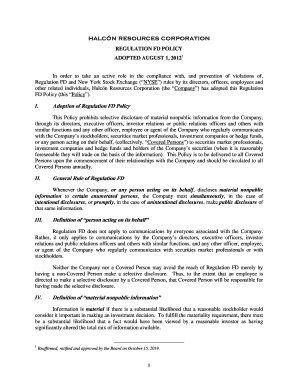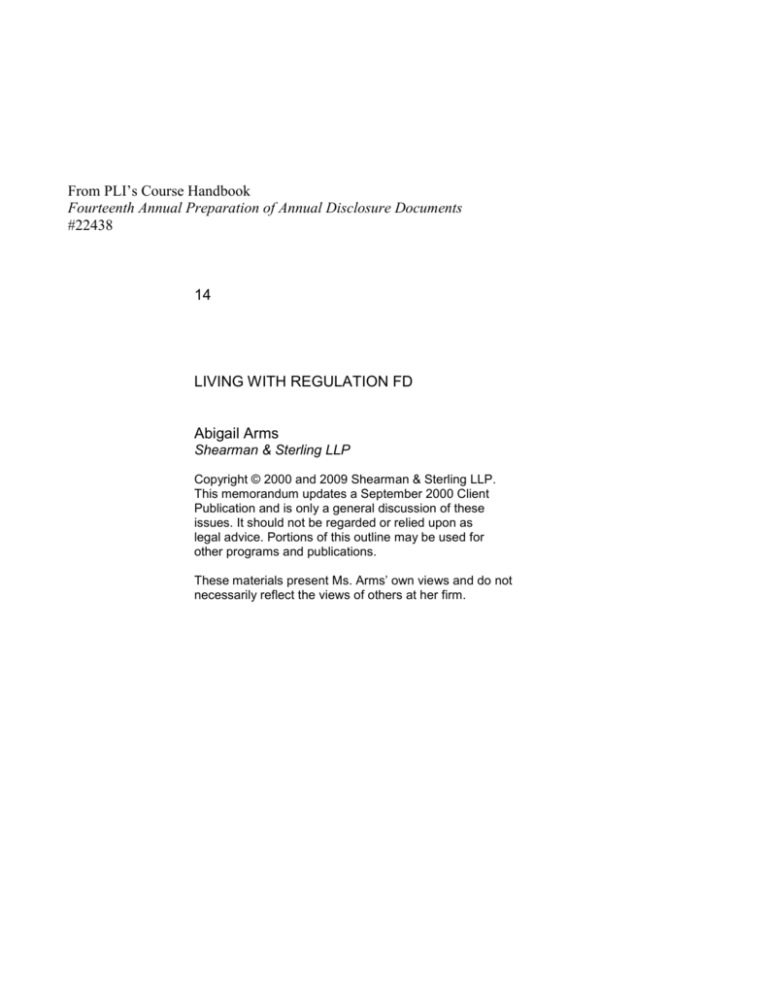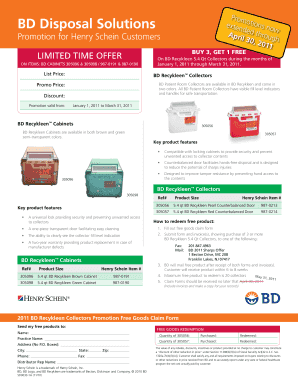Regulation Fd Policy : What it is
Regulation FD Handbook: An Overview of the Policy Regulation FD (Fair Disclosure) is an important policy that aims to promote fairness and transparency in the financial markets. In simple terms, it prohibits selective disclosure of material nonpublic information by public companies to certain individuals or entities. This policy ensures that all investors have equal access to information that may impact their investment decisions. In this post, we will delve deeper into the Regulation FD policy, discussing its implications, the need for its implementation, and how public companies can adhere to its guidelines. This guide will provide you with a comprehensive understanding of this policy and its significance in the corporate world. I. Understanding Regulation FD Regulation FD, also known as "Fair Disclosure," was introduced by the Securities and Exchange Commission (SEC) in 2000. It was implemented to address the issue of selective disclosure of material information to a few market participants, giving them an unfair advantage over others. The main objective of Regulation FD is to ensure that all investors have equal access to material information regarding publicly traded companies. It aims to level the playing field, preventing any potential information asymmetry among investors. II. The Implications of Regulation FD To comply with Regulation FD, public companies need to adopt fair practices while disclosing material nonpublic information. The policy requires that any material information be disclosed to the general public simultaneously, ensuring that all investors have access to the same information at the same time. The implications of Regulation FD are significant. By eliminating selective disclosure, the policy promotes fairness and transparency in the financial markets. It prevents insider trading and helps maintain investor confidence in the integrity of the market. III. Adhering to Regulation FD Guidelines Public companies must be cautious when it comes to disclosing material information. They need to ensure that such information is disseminated in a fair and non-exclusionary manner. Here are some best practices for companies to adhere to Regulation FD guidelines: 1. Prompt Public Disclosure Whenever a public company becomes aware of any material nonpublic information, it must promptly disclose that information to the general public. This ensures that no individual or entity gains an unfair advantage by having access to selective information. 2. Public Disclosure Methods Public companies have several options for disclosing material information, such as press releases, regulatory filings, company websites, and social media platforms. These methods ensure broader dissemination and equal access to information for all investors. 3. Avoiding Selective Disclosure Public companies should avoid providing material information selectively to certain individuals or entities. This includes analysts, institutional investors, or anyone with the potential to trade securities based on the disclosed information. Fairness and equal access are key principles of Regulation FD. IV. An Expert Perspective: Insights from the Corporate Counsel We reached out to The Corporate Counsel, a leading authority on corporate law, for their expert insights on Regulation FD. According to their analysis, Regulation FD has significantly contributed to the level playing field in the financial markets. Companies now have clearer guidelines on fair disclosure practices, enabling a more transparent and equitable market environment. The Corporate Counsel emphasizes the importance of public companies embracing the principles of Regulation FD. By doing so, companies not only comply with the policy but also strengthen their reputation, build trust with stakeholders, and mitigate potential legal risks. V. Examination of Real-World Examples Let's explore two real-world examples that highlight the significance of Regulation FD and its impact on corporate practices: 1. The Memo Regarding Regulation FD by LSTA LSTA, a leading organization in the loan and trading markets, has released a memo on the implications of Regulation FD. The memo emphasizes the need for public companies to avoid selective disclosure and provides practical guidance on compliance with the policy. It serves as a valuable resource for companies navigating the complexities of Regulation FD. [Image 1: Memo Regarding Regulation FD - LSTA] Image: LSTA - Memo Regarding Regulation FD 2. Regulation FD Handbook by The Corporate Counsel The Corporate Counsel has developed a comprehensive handbook on Regulation FD, offering a deep dive into its provisions and implications. This invaluable resource serves as a go-to guide for companies seeking to understand the nuances of the policy and how to implement best practices. [Image 2: Regulation FD Handbook by The Corporate Counsel] Image: The Corporate Counsel - Regulation FD Handbook VI. Subheading 1: Ensuring Equal Access to Information One of the fundamental goals of Regulation FD is to ensure equal access to material information. The policy aims to prevent any organization or individual from gaining an unfair advantage in the markets. By mandating simultaneous public disclosure, Regulation FD fosters transparency and trust among investors. VII. Subheading 2: Best Practices for Corporate Disclosure Public companies need to adopt best practices for corporate disclosure to comply with Regulation FD. These practices not only ensure adherence to the policy but also foster a relationship of trust and credibility with shareholders and the investing community. 1. Prompt dissemination of material information: Companies should promptly disclose any material nonpublic information to the general public, ensuring that all investors have simultaneous access to the information. 2. Utilization of multiple channels: Companies can leverage various communication channels such as press releases, regulatory filings, and their official websites to disseminate material information widely. 3. Social media disclosure: With the rise of social media platforms, companies may also consider using these channels to disclose material information. However, it is essential to ensure compliance with Regulation FD guidelines and avoid any potential pitfalls. VIII. Subheading 3: Frequently Asked Questions (FAQ) To provide a more comprehensive understanding of Regulation FD, we have compiled a list of frequently asked questions. These FAQs aim to address common queries and concerns related to the policy. Q1: What is considered material information under Regulation FD? A1: Material information refers to any information that, if disclosed to the public, could potentially impact the stock price or investment decisions of shareholders. Examples include financial results, mergers and acquisitions, significant regulatory changes, or any event that could significantly influence the company's operations or prospects. Q2: Is there a specific timeframe for disclosing material information under Regulation FD? A2: While Regulation FD does not specify a specific timeframe, public companies are expected to disclose material information promptly after becoming aware of it. Prompt disclosure ensures that all investors have equal access to the information, eliminating the possibility of selective disclosure. Q3: What are the consequences of non-compliance with Regulation FD? A3: Non-compliance with Regulation FD can have severe consequences for public companies. It can lead to reputational damage, loss of investor confidence, potential legal actions, and regulatory sanctions. It is crucial for companies to prioritize fair disclosure practices to avoid such implications. IX. Conclusion Regulation FD plays a pivotal role in promoting fairness and transparency in the financial markets. By requiring public companies to disclose material nonpublic information to the general public simultaneously, the policy levels the playing field for all investors. Adherence to Regulation FD guidelines ensures fair practices and mitigates the risk of selective disclosure. Public companies must understand the implications of this policy and embrace the best practices for corporate disclosure. By doing so, they not only comply with regulatory requirements but also enhance their reputation and foster trust among stakeholders. Remember, Regulation FD is a vital component of a well-functioning and equitable financial marketplace. As investors, analysts, and market participants, it is crucial to be aware of its provisions and encourage its implementation for the benefit of all.  Image Source : www.securitieslawyer101.com
Image Source : www.securitieslawyer101.com  Image Source : www.pdffiller.com
Image Source : www.pdffiller.com  Image Source : studylib.net
Image Source : studylib.net  Image Source : gilmartinir.com
Image Source : gilmartinir.com  Image Source : www.fsi.no
Image Source : www.fsi.no  Image Source : www.pdffiller.com
Image Source : www.pdffiller.com  Image Source : ccrcorp.com
Image Source : ccrcorp.com  Image Source : www.lsta.org
Image Source : www.lsta.org
Regulation FD And Social Media L Securities Lawyer 101 Blog
 Image Source : www.securitieslawyer101.com
Image Source : www.securitieslawyer101.com fd social regulation securities lawyer
Fillable Online In Order To Take An Active Role In The Compliance With
 Image Source : www.pdffiller.com
Image Source : www.pdffiller.com Living With Regulation FD - Practising Law Institute
 Image Source : studylib.net
Image Source : studylib.net Understanding Regulation FD – Gilmartinir
regulation fd understanding
FD - Policy For Forsvarssektorens Forvaltning Av Rettigheter Til
 Image Source : www.fsi.no
Image Source : www.fsi.no Fillable Online CORPORATE QUESTIONNARIE Fax Email Print - PdfFiller
 Image Source : www.pdffiller.com
Image Source : www.pdffiller.com Regulation FD Handbook | The Corporate Counsel
 Image Source : ccrcorp.com
Image Source : ccrcorp.com counsel corporate regulation fd
Memo Regarding Regulation FD - LSTA
 Image Source : www.lsta.org
Image Source : www.lsta.org Regulation fd handbook. Memo regarding regulation fd. Fillable online corporate questionnarie fax email print. Living with regulation fd. Fd social regulation securities lawyer